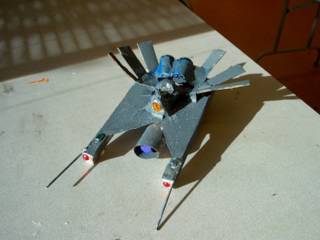About Me
- Name: Profile
- Location: Waterbury, Vermont, United States
Nan is a licensed art educator (K-12) and gifted education specialist ( PreK-12). She is a member of the Teaching for Artistic Behavior partnership (TAB), National Art Education Association & National Association for Gifted Children.
Links
Archives
- November 2004
- December 2004
- January 2005
- February 2005
- March 2005
- April 2005
- May 2005
- June 2005
- August 2005
- September 2005
- October 2005
- November 2005
- December 2005
- January 2006
- February 2006
- March 2006
- April 2006
- May 2006
- August 2006
- September 2006
- October 2006
- November 2006
- March 2007
- April 2007
- August 2007
- September 2007
- October 2007
- January 2008
- February 2008
- March 2008
- August 2008
- September 2008
- October 2008
- November 2008
- January 2009
- February 2009
- April 2009
Recommended Reading
A place to see what is happening in Fine Arts at Rocky Mountain School for the Gifted and Creative
Monday, November 29, 2004
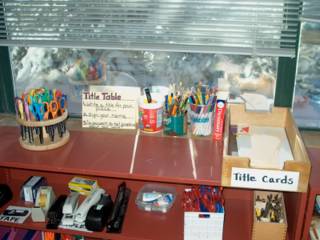
A new "Mini-Center" has been added to the art room. Students can now create a title card for finished work. Center includes strips of paper, markers, edging scissors, a dictionary (for ME!) and is adjacent to the collage center, which allows an artist embellish the title further if desired. It is my hope that this "final stop" will provide for reflection on a piece, and help prepare art for display. Other centers available each day include: Painting, Drawing, Construction, Collage and Weaving.
Monday, November 22, 2004
Did Painters of the Renaissance Use Optics ? Inquiring Minds Want To Know...
What accounts for the leap in artistic technique during the renaissance? How did artists achieve an "almost photographic realism"? Was it the rebirth of knowledge from the classical age? Was it the result of apprenticeship, genius or study? Was it the product of science, math and training in a new middle class society that valued the arts? Or was there some smoke and mirrors at play? Students in the middle school program explore the theory put forth by artist David Hockney, that painters as early as 1400 may have used optics as a basis for their paintings. Students are attempting to replicate Hockney's work and the techniques European masters may have used, by building simple box cameras of their own design. We are also attempting to turn a room at school into a camera. Later, a refrigerator box will become an outdoor studio. The goal is to produce a projected image that is clear enough to use to paint from.
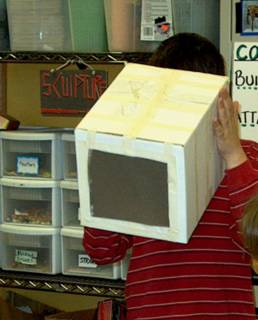
Middle school students participating in the Photography elective this quarter are "re-inventing the wheel", as they try to produce a projected image with various optical techniques.
Tuesday, November 16, 2004
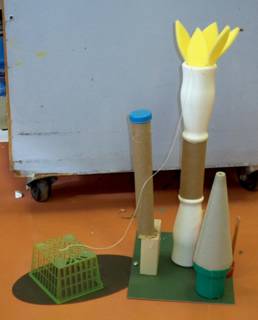
This "puff ball fun house" was constructed with purpose and patience over about six art classes by a five year old student. It is part habitat, part art object and part toy.
On Toilet Paper Tubes, Scotch Tape and Strawberry Baskets
Many of you are familiar with the universal developmental sequence that takes place as children begin to draw. Just as babies progress from scooting to crawling and finally to walking, children move predictably in their drawings from the scribble stage to the schematic stage to the realistic stage. It is interesting to note that making images is a universal human activity. It is also interesting that at a certain point, most people simply stop image-making altogether. “According to Peter London in No More Secondhand Art; “We have learned to be embarrassed by our efforts. We have learned to feel so inept and disenfranchised from our own visual expression that we simply stop doing it altogether”. Perhaps, sadly, this is the last developmental stage of image making for many.
Many of us are not as familiar or comfortable with the developmental stages of three-dimensional work, yet no doubt a similar progression exists. In order to create a sculptural piece of art, students must learn a great deal about balance and support. Students discover how to attach one object to another, how to achieve height, width and unity. Early sculptural attempts may look no more organized than a 3 year old’s scribble, but are just as necessary and valid as those early marks with crayon or marker. A great deal of learning is taking place when a student engineers a three-dimensional object. What materials are interesting and available? Should one glue, tape, staple or lash? Which glue works best for which material? Is the hot glue gun REALLY the savior of all things 3-D? How does one support a heavy object? What surface treatment adds beauty, interest or definition? Should the sculpture be free standing, or attached to a base? Is the object functional or decorative? Many meaningful questions arise while constructing objects in art. Although the results do not always accurately reflect the importance of the process, the process has real value, and is a meaningful aspect of the authentic work of artists.
I suspect those of you who house vast landscapes of structures made from cardboard, paper tubes and pipe cleaners are pulling your hair out, wondering how to find room to store and display all this recycled… stuff. More importantly, you may be struggling with how to admire and validate the work your child is so proud of.
Some parents and teachers are quite savvy in talking about art with children. Instead of asking, “What IS that?” many people considerately inquire “Would you like to tell me about your picture (or sculpture or mobile or weaving or????)?” Some parents allow a certain spot at home for display, and when it is full, a child must select things that need to “go” in order to make room for new pieces. Another tactic is to agree to display a piece for a little while, and then take it apart in order to re-use or recycle the parts. It is not necessary to keep every object your child drags home indefinitely, and children will understand that there is simply not room for it all. While a certain period of admiration and display is welcome, much of this early sculpture is much more about process than product, and the resulting object may have relatively little importance to your child once it is complete.
In passed years, on one day near the end of the school year, I would set up an “inventor’s workshop”.Toilet paper tubes, scraps of Styrofoam, tape and staples would come out and in a flurry of excited enthusiasm, students would create something that was of importance to them. It was by far the most popular activity I facilitated. Some students waited all year for this one glorious day. It is little surprise that the “Construction Center” in the art room is the most popular workstation right now, and while the objects that leave my room are sometimes challenging for adults, it is important is to recognize the significance and value of creative construction. One must learn to walk before one can run.
-Nan
Many of us are not as familiar or comfortable with the developmental stages of three-dimensional work, yet no doubt a similar progression exists. In order to create a sculptural piece of art, students must learn a great deal about balance and support. Students discover how to attach one object to another, how to achieve height, width and unity. Early sculptural attempts may look no more organized than a 3 year old’s scribble, but are just as necessary and valid as those early marks with crayon or marker. A great deal of learning is taking place when a student engineers a three-dimensional object. What materials are interesting and available? Should one glue, tape, staple or lash? Which glue works best for which material? Is the hot glue gun REALLY the savior of all things 3-D? How does one support a heavy object? What surface treatment adds beauty, interest or definition? Should the sculpture be free standing, or attached to a base? Is the object functional or decorative? Many meaningful questions arise while constructing objects in art. Although the results do not always accurately reflect the importance of the process, the process has real value, and is a meaningful aspect of the authentic work of artists.
I suspect those of you who house vast landscapes of structures made from cardboard, paper tubes and pipe cleaners are pulling your hair out, wondering how to find room to store and display all this recycled… stuff. More importantly, you may be struggling with how to admire and validate the work your child is so proud of.
Some parents and teachers are quite savvy in talking about art with children. Instead of asking, “What IS that?” many people considerately inquire “Would you like to tell me about your picture (or sculpture or mobile or weaving or????)?” Some parents allow a certain spot at home for display, and when it is full, a child must select things that need to “go” in order to make room for new pieces. Another tactic is to agree to display a piece for a little while, and then take it apart in order to re-use or recycle the parts. It is not necessary to keep every object your child drags home indefinitely, and children will understand that there is simply not room for it all. While a certain period of admiration and display is welcome, much of this early sculpture is much more about process than product, and the resulting object may have relatively little importance to your child once it is complete.
In passed years, on one day near the end of the school year, I would set up an “inventor’s workshop”.Toilet paper tubes, scraps of Styrofoam, tape and staples would come out and in a flurry of excited enthusiasm, students would create something that was of importance to them. It was by far the most popular activity I facilitated. Some students waited all year for this one glorious day. It is little surprise that the “Construction Center” in the art room is the most popular workstation right now, and while the objects that leave my room are sometimes challenging for adults, it is important is to recognize the significance and value of creative construction. One must learn to walk before one can run.
-Nan
Friday, November 12, 2004
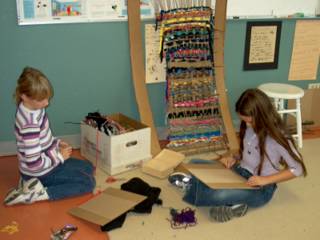
Our large group weaving piece is nearly complete. Students have added twigs, ribbon, leather, cellophane, yarn, rafia, twine and fabric strips. It has inspired several students to begin their own weaving on cardboard looms.
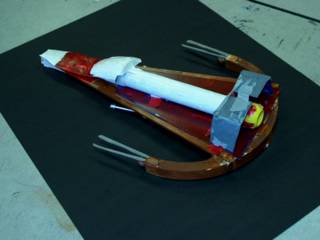
STAR SHIP - Built with care over several sessions, this starship was a prototype for others to come.

DISCOVERY AND INNOVATION:After trying a liquid glue stick, this student devised a unique way to connect foam shapes to form a chain. By the time he was done, the chain was about four feet long.
Starting a Choice Based Art Program
What’s New in the Art Room?
“Art this year is going to be much more fun, because we get to do what we want and be really creative”. – Student in Mrs. C’s class
“I have a sore throat, and I only came to school because today is art” – Student in Nancy’s class.
Moving to our beautiful new school, and finally having a real art room has facilitated a fresh approach in the fine arts program. Students this year are enjoying new freedom, greater accessibility to materials and increased responsibility for their own art making.
Recent research in the field stresses the importance of relevance, meaning and ownership in the creative process. Students are being asked to approach art making in a new way, and are more motivated and engaged than I have ever seen.
In the art room, students are treated as artists and offered authentic choices for responding to their own ideas and interests. Students make choices about what materials to use to express their idea, set up their materials and space, and are responsible for cleaning up and putting things away. Students generate ideas, overcome obstacles and set- backs, and choose to work alone or with peers. Students are expected to reflect on and discuss their finished work. This is the authentic work of real artists.
The introduction of new concepts, techniques, art history, contemporary topics and multi-cultural arts are delivered in short sessions at the start of each class. Students are then invited to further investigate the new concept, or move to various other“centers” in the room to pursue their current interest. Centers include tools, materials and instructions as well as resources and art reproductions. Students have the opportunity to concentrate in one area, becoming “expert” with a particular material or method. They may repeat a process or revisit an idea, in effect working in series to produce a “suite” of related work. Or, students may choose to move between several centers in a single art period, sampling a variety of opportunities. Students are asked to consider ways to reach in a project, finding deeper meaning, greater competence and improved skill. Content and resources can be targeted to individuals and small groups in response to current activities. Students are encouraged to evaluate their efforts, and describe their work to others.
Moving toward a choice-based program empowers students to take greater control of their learning, to find and communicate personal meaning through art and have the freedom to explore their own ideas and passions. A choice based art program honors and empowers the student as artist, nurturing and protecting qualities that lead toward inquisitive, confident, inventive, tolerant, capable human beings.
- Nan
Sources:
TAB(Teaching for Artistic Behavior)Website: http://knowledgeloom.org/tab/index.jsp
The Case for Constructivist Classrooms –Jacqueline Grennon Brooks, Martin G Brooks
The Art of Teaching Art to Children - Nancy Beal
No More Second Hand Art: Awakening the Artist Within – Peter London
“Art this year is going to be much more fun, because we get to do what we want and be really creative”. – Student in Mrs. C’s class
“I have a sore throat, and I only came to school because today is art” – Student in Nancy’s class.
Moving to our beautiful new school, and finally having a real art room has facilitated a fresh approach in the fine arts program. Students this year are enjoying new freedom, greater accessibility to materials and increased responsibility for their own art making.
Recent research in the field stresses the importance of relevance, meaning and ownership in the creative process. Students are being asked to approach art making in a new way, and are more motivated and engaged than I have ever seen.
In the art room, students are treated as artists and offered authentic choices for responding to their own ideas and interests. Students make choices about what materials to use to express their idea, set up their materials and space, and are responsible for cleaning up and putting things away. Students generate ideas, overcome obstacles and set- backs, and choose to work alone or with peers. Students are expected to reflect on and discuss their finished work. This is the authentic work of real artists.
The introduction of new concepts, techniques, art history, contemporary topics and multi-cultural arts are delivered in short sessions at the start of each class. Students are then invited to further investigate the new concept, or move to various other“centers” in the room to pursue their current interest. Centers include tools, materials and instructions as well as resources and art reproductions. Students have the opportunity to concentrate in one area, becoming “expert” with a particular material or method. They may repeat a process or revisit an idea, in effect working in series to produce a “suite” of related work. Or, students may choose to move between several centers in a single art period, sampling a variety of opportunities. Students are asked to consider ways to reach in a project, finding deeper meaning, greater competence and improved skill. Content and resources can be targeted to individuals and small groups in response to current activities. Students are encouraged to evaluate their efforts, and describe their work to others.
Moving toward a choice-based program empowers students to take greater control of their learning, to find and communicate personal meaning through art and have the freedom to explore their own ideas and passions. A choice based art program honors and empowers the student as artist, nurturing and protecting qualities that lead toward inquisitive, confident, inventive, tolerant, capable human beings.
- Nan
Sources:
TAB(Teaching for Artistic Behavior)Website: http://knowledgeloom.org/tab/index.jsp
The Case for Constructivist Classrooms –Jacqueline Grennon Brooks, Martin G Brooks
The Art of Teaching Art to Children - Nancy Beal
No More Second Hand Art: Awakening the Artist Within – Peter London
Monday, November 08, 2004

Students began weaving twigs left over from something else into a group weaving project. This student wondered what it would be like to make a weaving using just sticks.


Drawing and writing with a quill pen morphed into re-visiting sumi-e ink painting for some middle school students. Students were wrapping up exploration of the arts of early America when the quill and ink exploration reminded them of asian brush painting from last year. Here is an especially lovely result.

Sunday, November 07, 2004
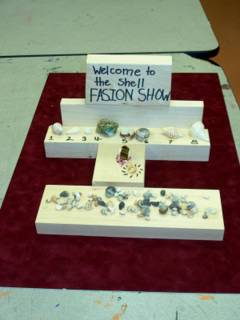
This young artist invited interaction by requesting viewers to vote for their favorite shell. An "announcer dude" is a polished rock holding "the envalope" while standing by a sparkling trophy (the shell of a tube worm). An audience of shells crowds the forground.

Choice Based Art
At RMS, students do the real work of artists. Students generate thier own ideas and pursue questions and problems of their own design. The art room is organized into centers to facilitate student selection of materials and methods best suited to communicate their ideas. Typically, each class starts with a brief introduction of a new material, tool or technique. Art history and issues in contemporary art are woven into work sessions. Connections are made by students and instructor, as past experiences,art movements and innovations are related to current interests and explorations.

